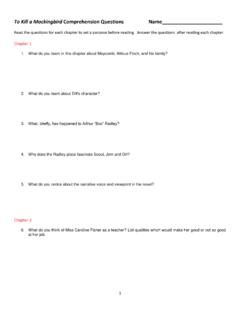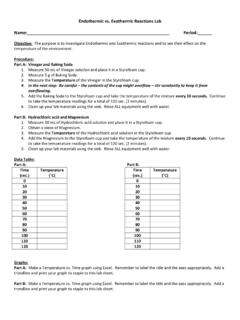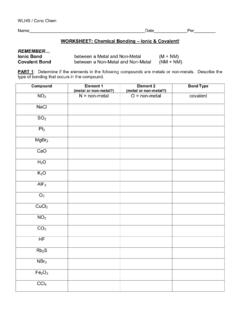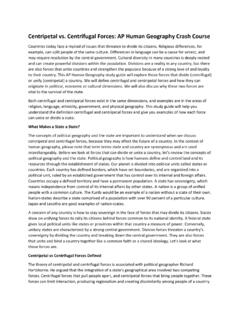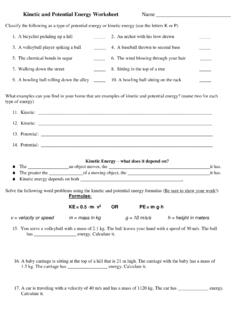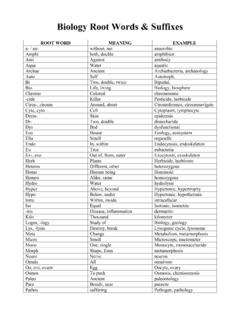Transcription of Important Concepts not on the AP Statistics Formula Sheet
1 Important Concepts not on the AP Statistics Formula Sheet Part I: IQR = Q3 Q1 Linear transformation: When describing data: Histogram: Test for an outlier: Addition: affects center NOT describe fairly symmetrical (IQR) above Q3 or below spread center, spread, and unimodal Q1 adds to , M, Q1 , Q3, IQR shape. The calculator will run the test for you as long as you not Give a 5 number choose the boxplot with the summary or mean and oulier on it in STATPLOT Multiplication: affects both standard deviation when center and spread necessary. multiplies , M, Q1 , Q3, IQR, . skewed Skewed left Ogive (cumulative Boxplot (with an right frequency) outlier). Stem and leaf Normal Probability Plot r: correlation coefficient, The strength of the linear relationship of data. Close to 1 or -1 is very close to linear HOW MANY STANDARD r2: coefficient of DEVIATIONS AN determination.
2 How well OBSERVATION IS FROM the model fits the data. THE MEAN Close to 1 is a good fit. The 80th percentile means that Percent of variation in y 80% of the data is below that Rule for described by the LSRL on observation. Normality x . N( , ). N(0,1) Standard Normal residual = Exponential Model: Explanatory variables Lurking Variable: A. y = abx take log of y explain changes in variable that may residual = response variables. influence the relationship observed predicted Power Model: EV: x, independent bewteen two variables. y = axb take log of x and y RV: y, dependent LV is not among the EV's y = a+bx Slope of LSRL(b): rate of change in y for every unit x y-intercept of LSRL(a): y when x = 0. Confounding: two variables are confounded when the effects of an RV.
3 Cannot be distinguished. Regression in a Nutshell Given a Set of Data: Enter Data into L1 and L2 and run 8:Linreg(a+bx). The regression equation is: predicted fat gain ( NEA). y-intercept: Predicted fat gain is kilograms when NEA is zero. slope: Predicted fat gain decreases by .00344 for every unit increase in NEA. r: correlation coefficient r = - Moderate, negative correlation between NEA and fat gain. r2: coefficient of determination r2 = of the variation in fat gained is explained by the Least Squares Regression line on NEA. The linear model is a moderate/reasonable fit to the data. It is not strong. The residual plot shows that the model is a reasonable fit; there is not a bend or curve, There is approximately the same amount of points above and below the line.
4 There is No fan shape to the plot. Predict the fat gain that corresponds to a NEA of 600. predicted fat gain (600). predicted fat gain Would you be willing to predict the fat gain of a person with NEA of 1000? No, this is extrapolation, it is outside the range of our data set. Residual: observed y - predicted y Find the residual for an NEA of 473. First find the predicted value of 473: predicted fat gain (473) observed predicted = - = predicted fat gain Transforming Exponential Data y = abx Transforming Power Data y = axb Take the log or ln of y. Take the log or ln of x and y. The new regression equation is: The new regression equation is: log(y) = a + bx log(y) = a + b log(x). Residual Plot examples: Linear mode is a Good Fit Curved Model would be a good fit Fan shape loses accuracy as x increases Inference with Regression Output: Construct a 95% Confidence interval for the slope of the LSRL of IQ on cry count for the 20 babies in the study.
5 Formula : df = n 2 = 20 2 = 18. b t *SEb ( )( ). ( , ). Find the t-test statistic and p-value for the effect cry count has on IQ. From the regression analysis t = and p = Or b t SEb s = This is the standard deviation of the residuals and is a measure of the average spread of the deviations from the LSRL. Part II: Designing Experiments and Collecting Data: Sampling Methods: The Bad: Voluntary sample. A voluntary sample is made up of people who decide for themselves to be in the survey. Example: Online poll Convenience sample. A convenience sample is made up of people who are easy to reach. Example: interview people at the mall, or in the cafeteria because it is an easy place to reach people. The Good: Simple random sampling. Simple random sampling refers to a method in which all possible samples of n objects are equally likely to occur.
6 Example: assign a number 1-100 to all members of a population of size 100. One number is selected at a time from a list of random digits or using a random number generator. The first 10 selected without repeats are the sample. Stratified sampling. With stratified sampling, the population is divided into groups, based on some characteristic. Then, within each group, a SRS is taken. In stratified sampling, the groups are called strata. Example: For a national survey we divide the population into groups or strata, based on geography - north, east, south, and west. Then, within each stratum, we might randomly select survey respondents. Cluster sampling. With cluster sampling, every member of the population is assigned to one, and only one, group. Each group is called a cluster.
7 A sample of clusters is chosen using a SRS. Only individuals within sampled clusters are surveyed. Example: Randomly choose high schools in the country and only survey people in those schools. Difference between cluster sampling and stratified sampling. With stratified sampling, the sample includes subjects from each stratum. With cluster sampling the sample includes subjects only from sampled clusters. Multistage sampling. With multistage sampling, we select a sample by using combinations of different sampling methods. Example: Stage 1, use cluster sampling to choose clusters from a population. Then, in Stage 2, we use simple random sampling to select a subset of subjects from each chosen cluster for the final sample. Systematic random sampling. With systematic random sampling, we create a list of every member of the population.
8 From the list, we randomly select the first sample element from the first k subjects on the population list. Thereafter, we select every kth subject on the list. Example: Select every 5th person on a list of the population. Experimental Design: A well-designed experiment includes design features that allow researchers to eliminate extraneous variables as an explanation for the observed relationship between the independent variable(s) and the dependent variable. Experimental Unit or Subject: The individuals on which the experiment is done. If they are people then we call them subjects Factor: The explanatory variables in the study Level: The degree or value of each factor. Treatment: The condition applied to the subjects. When there is one factor, the treatments and the levels are the same.
9 Control. Control refers to steps taken to reduce the effects of other variables ( , variables other than the independent variable and the dependent variable). These variables are called lurking variables. Control involves making the experiment as similar as possible for subjects in each treatment condition. Three control strategies are control groups, placebos, and blinding. Control group. A control group is a group that receives no treatment Placebo. A fake or dummy treatment. Blinding: Not telling subjects whether they receive the placebo or the treatment Double blinding: neither the researchers or the subjects know who gets the treatment or placebo Randomization. Randomization refers to the practice of using chance methods (random number tables, flipping a coin, etc.)
10 To assign subjects to treatments. Replication. Replication refers to the practice of assigning each treatment to many experimental subjects. Bias: when a method systematically favors one outcome over another. Types of design: Completely randomized design With this design, subjects are randomly assigned to treatments. Randomized block design, the experimenter divides subjects into subgroups called blocks. Then, subjects within each block are randomly assigned to treatment conditions. Because this design reduces variability and potential confounding, it produces a better estimate of treatment effects. Matched pairs design is a special case of the randomized block design. It is used when the experiment has only two treatment conditions; and subjects can be grouped into pairs, based on some blocking variable.
